ON THE TOWN… With CHIP DEFFAA
I’ve been spending a good bit of time, of late, in the recording studio. It makes me very happy that we’ve now completed, and have just released, the original cast album for my show “Mad About the Boy,” with the terrific company from our production at the 13th Street Theater: John Brady, Cody Jordan. Joris de Graaf, Luca Fric, Benjamin Grier, Amanda Andrews, Katherine Paulsen, Toby Medlyn, Maite Uzal, Michael Knowles, Shinice Hemmings, Michael J. C. Anderson, Al Roths, Richard Danley. I was very proud of that whole cast and am delighted to have their good work documented. And it’s available now from Amazon.com, CDBaby.com, etc.
Because the theater is my first love, I always relish attending the Tony Awards. I’ve been attending faithfully for many years.
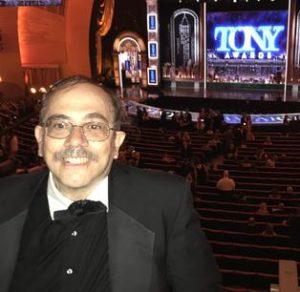
Chip Deffaa at the Tonys
It’s my favorite annual event. And long before I was able to attend in person, of course, I was watching each year on TV–ever since the very first national broadcast of the Tonys.
In five decades of watching the Tonys, I’ve never seen a blunder that was the equal of the blunder that was allowed to occur this year. Bette Middler, starring in “Hello, Dolly!,” was the biggest, most talked-about event of the theatrical season. And “Hello, Dolly!” certainly collected its share of Tony Awards.
But Bette Midler did not perform on the Tonys. Ouch! That left a gaping hole in the awards ceremony. “Hello, Dolly!” was represented, in a small way, by David Hyde Pierce (who plays Horace Vandergelder in the musical) singing a minor number, “Penny in my Pocket,” that Gower Champion wisely cut from the original production before it opened on Broadway.
Now David Hyde Pierce is a likeable enough performer, but there’s simply not much of a “wow factor” in that particular number. And the way it’s arranged for the show, there’s not even a proper button at the end of it, to prompt extra applause. (More can be made of the material, if desired; I’ve seen Lee Roy Reams, in his nightclub act, perform “Penny in My Pocket” with greater showmanship and flair.) Pierce’s performance of the song was pleasant but underwhelming. He’s not the star who’s been driving the ticket sales.
A way should have been found to have Midler performing on the Tonys. It would have been a win-win for everybody–for Midler, for the revival of “Hello, Dolly!,” for the Tony Awards telecast, and for the millions watching the television broadcast at home.
What went wrong? The official story is that an impasse developed between the “Hello, Dolly!” producers, including Scott Rudin, and the producers of the Tony Awards. Rudin, I’m told, offered to have Midler and company perform either the musical’s title song or “Before the Parade Passes By”–both tremendous production numbers, with huge audience appeal–but only if the performance were broadcast from the Shubert Theatre, where “Hello, Dolly!” plays. Tony officials insisted that the “Dolly” cast perform on the stage of Radio City Music Hall, along with everyone else. Because the Radio City Music Hall stage is larger than the Shubert Theater’s stage, the numbers would have had to have been adapted to the new stage. (Musicals performing at the Tony Awards typically make adaptations for the broadcast.)
“It’s my decision,” Rudin maintained. He said that both numbers were staged on and around a passerelle (a runway around the orchestra pit), which is bigger at Radio City Music Hall than at the Shubert. “I told the Tony producers that unless they wanted to watch 12 dancers falling into the pit live on CBS, doing either number at Radio City was simply a nonstarter,” Rudin said. He insisted he wanted his company to perform at the Shubert Theater, with cameras picking it up “live,” there.
The Tony producers turned Rudin down, fearing that other shows might then ask to do their numbers from their own theaters as well. Rudin said: “‘Dolly!’ and ‘Parade’ are beloved, iconic numbers from the Golden Age of Broadway musicals, and they mean a great deal to an enormous amount of people, myself included. Presenting weakened, watered-down, restaged-for-television versions of either of them holds no interest for any of us connected with the show.” Neither side, I’m told, was willing to budge. And a decision was made to have the musical represented by David Hyde Pierce singing “Penny in My Pocket,” solo, at Radio City Music Hall.
I wish someone in authority had been willing to bend a bit, or to think up a better alternative. I still remember the joy of seeing Pearl Bailey and the cast of “Hello, Dolly!” perform two numbers “live” on the 1968 Tony Awards. The entire ensemble put across “Put On Your Sunday Clothes,” and Bailey, solo, delivered “So, Long Dearie.” (I was tape-recording the numbers at home, on our family’s Wollensak reel-to-reel audio rape recorder; home videotape recorders did not yet exist.) Those numbers, incidentally, work brilliantly out of context. You don’t have to know anything about the musical “Hello, Dolly!” to delight in them. And I’m sure those exuberant performances on the Tony Awards broadcast sold a lot of tickets.
Midler is the “muscle” in the current revival of “Hello, Dolly!” She is selling the tickets. She has clout. If she had insisted she wanted to perform on the Tonys, I can’t help believing it would have happened. I would have loved to have seen her and the entire company do a big production number from their show–whether they performed it at Radio City Music Hall or at the Shubert Theater.
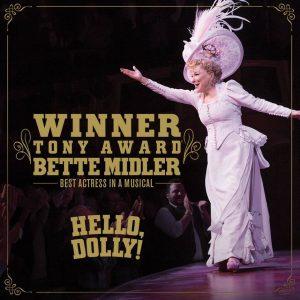
Bette Midler in Hello Dolly
But I would also have been happy if Midler had simply performed solo. She could have done “So Long, Dearie” by herself and brought down the house. Or she could have recited the key monologue in which she tells us of her desire to rejoin the human race, and then sing “Before the Parade Passes By,” solo. Carol Channing–the original “Dolly”–has made that terrifically theatrical combination of speech and song a staple of her personal appearances for many years.
Midler could have stolen the show, performing anything from the musical “Hello, Dolly,” whether by herself or with others. It simply felt wrong that she did not perform. Some friends in the theater community told me they felt she’d snubbed the theater community and her many fans by not performing.
Midler won–as everyone knew she would–the 2017 Tony Award for Best Actress in a Musical. And I liked her acceptance speech. She thanked Carol Channing and Pearl Bailey, the greatest stars who played “Dolly” in its original Broadway run; that was a classy and appropriate thing to do. When her acceptance speech ran past the allotted time and the orchestra went into play-off music, she brashly ordered the orchestra to stop playing so she could finish. And she finished. Like I said before, she has muscle. People listen to her.

Bette Midler
But I found it telling, and significant, that, when she finished her acceptance speech, she did not get a standing ovation. (And it’s not that hard to get a standing ovation at the Tonys. The performers are among friends. It’s the softest audience in the world. Ben Platt–who won the Tony as Best Actor in a musical, for “Dear Evan Hansen”–got a standing ovation. So did James Earl Jones–who won a special “Lifetime Achievement” Tony. Even Joe Biden’s wife–Dr. Jill Biden–got a standing ovation for her brief appearance.) Oh, I stood up for Bette Midler, and some others did. (I’ve always loved her work, and she’s the best thing that happened to Broadway this season.) But most people in that vast house did not stand. She’d lost the sympathy of a lot of people, I believe, by not performing.
I think the decision to not have her perform–whoever, ultimately, was responsible–was a major blunder. It took a bit of the bloom off of “Hello, Dolly!,” off of Midler,. and off of the Tony Awards. A way should have been found to have her perform on the Tonys. CBS should have been pushing in commercials for the Tonys that she’d be performing on the broadcast. It would have been good for everyone.
Ratings for the 2017 Tony Awards, according to initial reports from “Deadline,” were significantly lower than for the 2016 Tonys. The 2017 Tonys garnered a 4.7 metered market rating. (That means that about 4.7 percent of households with a TV set tuned in to the broadcast. Last year’s broadcast–boosted by excitement over “Hamilton”—drew a 6.8 rating and the 2015 broadcast drew a 5.1 rating.) Ratings, of course, are not everything. CBS has faithfully televised the Tonys for 39 years, and I hope they continue to do so for many more years. But ratings would have been higher, I’m sure, had the broadcast included a well-promoted appearance by Midler, whether it was from the stage of Radio City Music Hall or the Shubert. It would have been good, too, to have a bit of older-style Broadway music and showmanship represented on the Tony Awards, since the shows which received best-musical nominations all have more contemporary-sounding scores, and that’s not everyone’s preference.
There was, of course, much to enjoy at the Tony Awards. I loved hearing Ben Platt, in his acceptance speech, say: “To all young people watching at home, don’t waste any time trying to be like anybody but yourself because the things that make you strange are the things that make you powerful.” Young people need to hear that.

Benn Platt’s quote from his Tony acceptance speech.
In the first hour of the Tony Award presentations–from 7-8 p.m., the segment that is not televised “live”–I was particularly glad to see Baayork Lee and James Earl Jones presented with special Tony Awards, honoring their life’s work. They’ve both made such valuable contributions to the theater, I wish their awards could have been broadcast in full, “live” on TV.
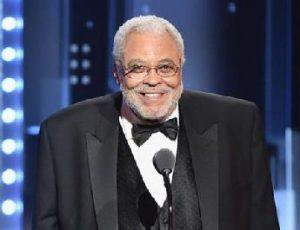
James Earl Jones
I liked seeing the playwrights, whose work had been nominated for the Tony Award, speak about their plays. It’s nice seeing the playwrights get some recognition, and it was a “different” way of introducing the Tony-nominated plays.
I enjoyed Kevin Spacey’s work as the host. He’s very likeable. And he’s versatile. But the big opening number for the Tony Awards broadcast, although clever, was far too “inside” to work for most viewers. To fully appreciate the number, you had to already be familiar with all four of the Tony-nominated musicals it referenced: “Dear Evan Hansen,” “Come from Away,” “Groundhog Day,” and “Come From Away.” I wonder how many TV viewers, in all parts of America, simply gave up on the Tony Awards midway through that opening number, feeling they were watching some kind of extended “inside joke” they were not privy to. No one likes to feel excluded. I’m sure a lot of viewers were puzzled by the first sight of Kevin Spacey, in casual clothes with bandaging around his forearm. He was costumed the way Ben Platt is costumed in “Dear Evan Hansen.” But unless you were already familiar with “Dear Evan Hansen”–and few viewers would have been–it made no sense.

Kevin Spacey at Tonys opening number
The broadcast’s opening number should be big and bright and brassy, and accessible–with enough showbiz razzle-dazzle to pull everyone in.

Ben Platt in Dear Evan Hansen
I must add, I also winced the way the opening number kept implying that Kevin Spacey had gotten the job of hosting the Tonys only because bigger “names” were unavailable. I know it’s a gag, but they presented it in such a heavy-handed way, I bet some young viewers across the country thought there was some truth in it. Spacey is actually a terrific stage actor, with sterling Broadway credentials. I’ll not soon forget his work in Eugene O’Neill’s demanding “The Iceman Cometh.” (That was an epic production.) And he’s tackled many other challenging roles, in Broadway productions of “Long Day’s Journey Int Night,” “A Moon for the Misbegotten,” “Hurly Burly,” and “Ghosts.” But the average television viewer would have had no way of knowing his importance as a stage actor. He certainly earned that hosting gig. Someone in the broadcast should have taken a moment to make that clear to all viewers.

Kevin Spacey
The Tony Awards telecast helps to promote Broadway–helps to sell tix to shows in New York and on the road. And it helps introduce the world of the theater to many people. That’s great. I just want the Tonys to do as good a job as possible, of both educating and entertaining viewers.
Incidentally, theater business is very good these days, both in New York and on the road. For the 2016-2017 Broadway season, the Broadway League reports, total Broadway attendance reached 13,270,343, and Broadway shows yielded $1,449,321,564.64 in box-office grosses, making it the highest-grossing season in Broadway recorded history and second-best attended season on record. I’m glad to see so many theaters in NYC filled. And the road is doing comparable business.
Well, enough about the Tonys. I was happy to be there, of course–it’s always inspiring for me to attend the Tonys, even if some elements disappointed me. Now I’d like to share comments on some noteworthy shows I haven’t commented this year.
* * *
As I reflect on the 2016-2017 theatrical season, I’d like to call attention to some performers and performances–on Broadway, off-Broadway, regionally–that, for one reason or another, left an impact on me.
The most memorable star turn by an actor in a play that I witnessed this past season? Easy! That’s Kevin Kline in Noel Coward’s “Present Laughter.” And I’m very glad he’s now won the Tony Award for his work. It’s a bravura performance I’ll remember forever–the best performance I’ve seen Kline give in a long and distinguished career.
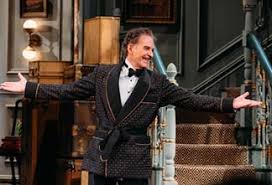
Kevin Kline
I’ve always enjoyed Kline’s work, going back to the musical comedy that made him a full-fledged Broadway star, “On the 20th Century” (which I saw nearly 40 years ago, in the very same Broadway theater that has been home to “Present Laughter” this season–the St. James). He was good in “On the 20th Century”–but he was upstaged in that production, at times, by the veteran in cast, Imogene Coca, whose comic timing was sheer perfection.
No one upstages Klein now. At the age of 69, he brings a lifetime of theatrical experience to this role. And I could not take my eyes off of him. He can make even the simplest business–sliding down a bit of bannister–compelling. He’s theatrical to the core.
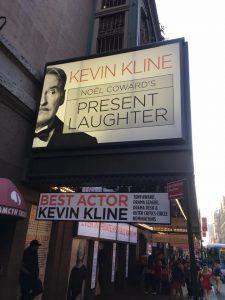
And although the whole play is generally well-cast (I particularly enjoyed the way Kristine Nielsen played off of him–great fun!), my interest in the proceedings dropped off just a bit when he left the stage. His character is supposed to be one of the great stars of the theater, and Kline mines the plummy role for all it’s worth. He found just the right tone. (One or two of the supporting players occasionally pushed too hard, strained for laughs too broadly.) Kline caught every laugh, but he also showed us the humanity in the character, who sometimes wishes there weren’t quite so many people making demands of him. A wonderfully nuanced, varied performance–a master class in acting. He knows when to be big, and when to show restraint.
Twenty years ago, I had the pleasure of seeing Frank Langella star in a Broadway production of “Present Laughter,” and he was so effective, I felt I’d seen a definitive interpretation then. When this season’s revival of “Present Laughter” was announced, I was in no particular hurry to see it, because I remembered so fondly Langella’s grandly over-the-top take on the material. And Langella is one of my favorite stage performers. But I enjoyed Kline’s interpretation of the role–which is different from Langella’s in that it’s got more vulnerability–as much, in its own way, as I’d enjoyed Langella’s. And that is saying plenty.

Kevin Kline
I liked his unassuming, old-school acceptance speech at the Tony Awards. He had presence. He didn’t push. And in his own quiet way, he seemed to embody–as much as anyone on stage that night–the Broadway I’ve always known and loved. He’s carrying on the tradition of Lunt and Fontanne, and Jason Robards, and Julie Harris, and so many other great stars of the American stage.
* * *
Outstanding ensemble work in a play? I’d like to salute the cast of “Six Degrees of Separation,” which has received an excellent revival on Broadway this season. No individual actor carries the show. All contribute to the success of the production: Allison Janney, John Benjamin Hickey, Corey Hawkins, Michael Siberry, Peter Mark Kendall, Sarah Mezzanotte, and a dozen more . If there is a “star,” it is the unusual, still-fascinating, and very well-constructed play itself. I was very glad to see playwright John Guare–one of my favorite living writers; he always mixes insight and wit so well, with a great feel for our times –join the cast on the stage for the curtain calls on opening night.
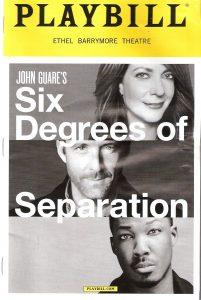
It’s funny how quickly time can sometimes seem to pass. To me, it was just a moment ago that the original production of “Six Degrees of Separation” opened in New York. (In fact, I was surprised that this play was being revived already, because in my memory it seemed like such a recent work; I was doubly surprised when I then checked the records and noted that the play’s original opening was in 1990, fully 27 years ago; even the outstanding film adaptation was made fully 24 years ago.) When the play first opened, it was simply set in “the present.” And it felt wholly contemporary. Now it evokes a particular time– a time that is a bit different from the present. The play still works. The Playbill now identifies the setting: New York City–1990.
The storyline (inspired by a real incident) has a prosperous, middle-aged white, liberal couple conned by a young black man who maintains that he is (a.) a friend of their children at Harvard University and (b.) the son of famed actor Sidney Poitier. He claims to have been mugged, and reaches out to the parents of his supposed friends for help. They befriend him. He tells them that his father has secured the film rights to the Broadway musical “Cats”–and suggests there might be parts for them to play in the production.
The parents, who are not at all close emotionally to their children, seem somehow comforted by the idea of being able to help one of their childrens’ friends, and also by the discovery that they are closer than they ever could have imagined, to the great Sidney Poitier. “Paul Poitier” (as the young con artist calls himself) assures the parents that we’re all much more closely connected than we might realize.
As the mother proclaims, in one of the play’s best monologues: “I read somewhere that everybody on this planet is separated by only six other people. Six degrees of separation between us and everyone else on this planet. The President of the United States, a gondolier in Venice, just fill in the names. I find it (a.) extremely comforting that we’re so close, and (b.) like Chinese water torture that we’re so close because you have to find the right six people to make the right connection… I am bound to everyone on this planet by a trail of six people… Every person is a new door, opening up into other worlds….”
It’s a first-rate script and story. It now feels like the product of an earlier time because nowadays–with it so easy to instantly find background information on anyone, online–it would be harder for a stranger to pull off such a con. But the emotional truths in the play remain valid.
(Incidentally, the real-life con man who actually tried to pass himself off, to friends of John Guare, as the son of Sidney Poitier, unsuccessfully sought to obtain a share of the play’s profits. Once a con artist….)
In the play, the couple begins to figure out they’ve been duped when the con man, who happens to be gay, brings home a male hustler. “Paul” tries to explain to the mother why he’d sought out a hustler, saying he felt so happy, he wanted to add sex to his happiness; to him, that seems like the most logical thing in the world. He asks her if she, too, doesn’t build upon happiness with sex. It’s a tribute to both Guare’s economical writing and Allison Janney’s skills as an actress that when she says simply, poignantly, no, we sense the emptiness in her life. And the emotional bond that forms between her an Paul makes sense.
The play, originally produced by Lincoln Center, was nominated for a Pulitzer Prize. And Jerry Zaks, who directed the original production, won a Tony Award for his work.
This production, directed by Trip Cullman, held me from start to finish. There are lots of sparkling moments. (And props to newcomer James Cusati-Moyer who certainly made the most of his brief–but vivid–scene as the hustler.) The production went off the tracks a bit only at one point, when the couple’s children were onstage; the director pressed too hard for laughs in that scene, making the children seem almost cartoon-like, caricatures of spoiled brats. They got big laughs, but broke the spell of realism that had existed until then. The son, in particular, seemed just about ready to throw a tantrum. I preferred the more honest and understated performance that young Anthony Rapp gave, when he played the son in both the original stage production and the subsequent film; the material is stronger if every character in “Six Degrees of Separation” is believable, realistic, and has his own intelligence. If the kids seem simply like over-the-top fools, it cheapens the play.
But that is a relatively minor complaint. This production is well worth seeing. I’d enjoy seeing it again.
However, I could have shot the fellow sitting near me who kept checking his cell phone throughout the performance. That’s very distracting (and could not have happened when this show first opened in 1990). And then just before the show ended–while I was engrossed in the conclusion of the play–he got up, muttered he didn’t want to miss his train–and tromped out, in front of those of us seated near him. Leaving before the play is over–and on an opening night yet?!? Opening nights were more formal and more glamorous when I was younger. And sometimes I miss that.
* * *
If I had to name one musical I saw this year that was deserving of greater recognition, it would be “Kid Victory” (by John Kander and Greg Pierce). It drew packed houses for a month-long limited engagement at the Vineyard Theater, Off-Broadway in New York City. I wish it could get an open-ended production at a somewhat larger house, whether off-Broadway or on Broadway, so more people could see it.

Kid Victory
Ambitious, intelligent, and beautifully nuanced, “Kid Victory” struck me as the most intriguing new musical I’d seen in a good while. It is too important a work to have only a four-week limited run in NYC.
It is not a “happy,” “feel-good,” commercial kind of show. It will not be every person’s cup of tea. But it is a significant, honest, insightful, and-often surprising new musical. It kept me interested throughout. Kander’s music is good for my soul. No living theater composer has given me more pleasure. And “Kid Victory,” which I liked a lot. deserves more of a life.
Years ago, composer John Kander and his late longtime collaborator, lyricist Fred Ebb, told me in an interview that they did not want to create shows that felt like mere copies of their previous shows; they wanted fresh challenges with each production In their long career, they created an extraordinary body of work, and each of their musicals–“Cabaret,” “Chicago,” “ The Act,” “Kiss of the Spider Woman,” “Steel Pier,” “Curtains,” “The Scottsboro Boys,” etc.–has its own unique feel. Kander has kept that admirable tradition going. In style and tone, “Kid Victory” is unlike any previous show he has done. It feels very much of our time, while containing–as all Kander shows do–enjoyable nods to the past.
The bracing story (jointly created by Kander and Pierce) deals with a midwestern youth who’d been abducted by a deranged predator.
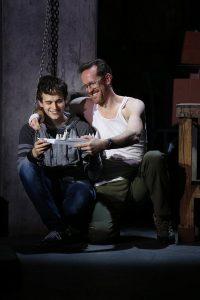
Kid Victory with Brandon Flynn and Jeffry Denman
He comes back home, after being gone for almost a year. His rigid, highly religious mother wants everything “back to normal”–with his returning to school, church, his old friends and girlfriend–as soon as possible. But it is not easy for him to even speak to anyone, and he hasn’t yet sorted out his own feelings. Others seem far more certain than he as to what he should be doing with his life.
Incidentally, this is the only musical I’ve ever seen in which the protagonist–who’s often feeling trapped–doesn’t get to sing at all, while everyone else does. Flashbacks gradually show us more and more of what he experienced in the time he was away. I don’t want to write more plot details, because I don’t want to spoil the surprises for potential audience-members.
But I give Kander and Pierce a lot of credit, It would have been very easy to create simplistic stock characters, wholly good or wholly evil. But subtleties give this show its strength; the writers have caught the ambiguities, uncertainties, and ambivalences of real life. Characters are etched with compassion and understanding. The yearnings, desires, and motivations of both the youth and his captor are delineated well. The story is told clearly. Pierce’s libretto is strong; this could have worked as a straight play–although of course the songs make it richer. There’s a good balance between spoken dialog and song. All characters get their due.
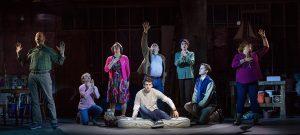
Kid Victory cast
The nine actors (directed by Liesl Tommy) have been very well cast. Karen Ziemba, as the youth’s mother, and Daniel Jenkins, as the father, helped give the show a firm foundation from the start. Newcomer Brandon Flynn carried off well the demanding role of the youth who’s struggling with so much. Dee Roscioli added warmth and comic relief. Jeffrey Denman handled persuasively the role of the captor. And newcomer Blake Zolfo shone brightly in a small but essential role. (He also got to sing and dance with great insouciance, one of the best numbers in the score, “What’s the Point?”)
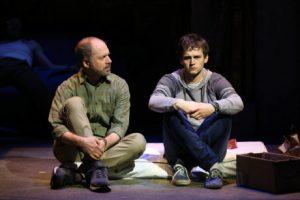
Kid Victory with Daniel Jenkins and Brandon Flynn. Photo by Carol Rosegg
The show runs an hour-and-forty-five-minutes without an intermission, which felt just about right. I wish the cop’s jauntily-sung interrogation of the youth could have gone on just a bit longer; that engaging musical number was cut off too quickly. And I wish there were a way to shoehorn one more lively number into that score, which is beautiful but often–due to the subject matter–understandably subdued. But I was enthralled from the first notes of the score. The 10-piece orchestra played Kander’s music superbly.
What a welcome addition to the theater season this show was. I hope it has more of a life, in New York and regionally.
* * *
Smallest show with the biggest laughs? “Spamilton.” No show this past season had me laughing more than the Off-Broadway hit “Spamilton.” Created, written, and directed by Gerard Alessandrini, it is a successor to his famed “Forbidden Broadway” shows of past years. The night I caught the show at the Triad Theater–it has since transferred to the 47th Street Theater–I was in a fair amount of physical pain from an injury. But Alessandrini’s production quickly made me forget every ache. 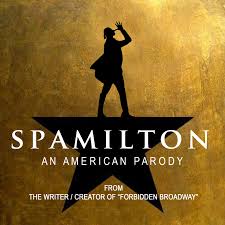
In 80 fast-moving minutes, his cast of five players (joined by two guest stars) and one hard-working music-director (Richard Danley, the night I attended) managed to send up not just Lin-Manuel Miranda and “Hamilton,” but everyone from Barak Obama and Glenn Close, to Stephen Sondheim, Barbra Streisand, and Judy Garland. Gags, spoofs, and musical parodies flew by so quickly that if you missed an occasional line, it didn’t matter. Alessandrini managed to make references to “The Book of Mormon,” “Cats,” “Aladdin,” “Rent,” “Annie,” “Gypsy,” the “Lion King,” and shows that don’t quite exist yet, like “An American Psycho in Paris.”
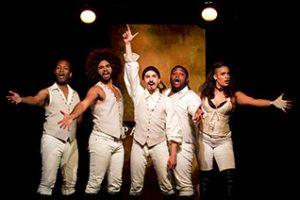
Spamilton
You don’t have to be familiar with “Hamilton” to have a good time; but you should have an appreciation for Broadway. One understudy–Cameron Amandus–went on at the performance I saw, and he was every bit as entertaining as his cohorts Tristan J. Shuler, Nicole Ortiz, Larry Owens, and Chris Anthony Giles. I loved their energy. (And I’ll follow with interest their future work. Alessandrini has a good track record, in terms of discovering promising unknowns.) I had a great time. This production is doing so well in New York that they’ve opened a Chicago company as well.
Incidentally, if we go back almost a quarter-century, it was Alessandrini who helped make Christine Pedi–the unchallenged contemporary master at conjuring up other show folk–a star. He showcased her in one production of “Forbidden Broadway” after another, in the late 1990’s and early 2000’s. I got to enjoy her evocations of Carol Channing, Liza Minnelli, Patti LuPone, and more, back then. And although she did not appear at the performance of “Spamilton” I attended, she often does make surprise appearances as a “guest diva” with this show.
* * *
The most intriguing workshop I saw this past year? Easy. That would be”The Belle of Tombstone,” by Sheilah Rae (book and lyrics), Michelle Brourman (music), and Thomas Edward West (book), directed by Joe Barros, and presented by the New York Theatre Barn. I don’t comment on most workshop productions, which by their very nature are works-in-progress. But each year, I like to call some attention–even if just writing briefly–to one workshop that impressed me.
I don’t judge a workshop quite the same way I would a finished work that is officially open and selling tickets to the public. But the score to “Belle of Tombstone” includes some unusually good, and nicely varied, songs. I enjoyed the best songs in this score at least as much as I enjoyed the songs in any of the shows that have opened on Broadway. That alone would be reason enough for me to hope that more will be done with this musical. In addition, the cast was about as strong as any I’ve ever seen in a workshop. Although this was presented “book-in-hand,” I was won over from the start by Heather Macrae and Karen Mason, whose singing and acting was sublime. Really top-drawer.
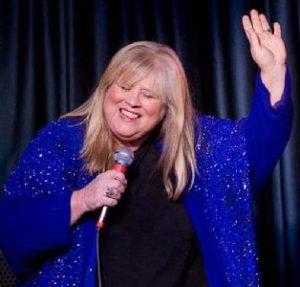
Heather Macrae
Sydney Shuck, Bonnie Milligan, Hannah Rose DeFlumeri, and Zorin Villanueva all had opportunities to shine. I loved the cast, and many of the songs. This is an all-female show, incidentally–every member of the cast is female. Which is a rarity.
I hesitate about commenting too deeply on a workshop, which might be considered a preliminary sketch for a finished show. (If I see a workshop that totally bores me–as sometimes happens– I’ll simply write nothing about it.) A workshop is a tryout, and people need room to try things out. But there’s some good stuff here, and I wish them well with it. Is there room for improvement? Of course! (There almost always is.) I’d think the creators may be trying, at present, to tell too much of the story through song. My hunch is that the show might be strengthened by taking out a few of the 24 musical numbers, and replacing them with book scenes. The texture might be better. And the strongest songs would stand out a little clearer.
* * *
If I had to name two leading ladies I saw this season who deserve to be better known, I’d name two women I saw doing first-rate work in regional productions of not-quite-first-rate shows–Elena Shadow, currently starring (through June 25th) in “Mary Poppins” at Paper Mill Playhouse, in Millburn, New Jersey, and Michelle Dawson, currently starring (through June 25th) in “ ”Mamma Mia” at the Westchester Broadway dinner theater, in Elmsford, New York. Both productions merit proper discussion.
If you’re looking for an enjoyable musical for the whole family, Paper Mill Playhouse’s big, bright, handsomely mounted production of “Mary Poppins” is more satisfying than many productions currently on Broadway, with ticket prices significantly lower than on Broadway. The stage adaptation of “Mary Poppins” (which enjoyed a long run on Broadway) has always been a good show–rather than a truly great show–with moments of real magic. The book and score are uneven. But there is still a good deal to savor. And Paper Mill has done about as effective a production of this property as any regional theater could ever hope to do. The glorious big production numbers–the best-loved numbers from the terrific 1964 Disney film–are carried off with such elan, you’ll likely overlook–of forgive–the parts of the show that don’t quite work.
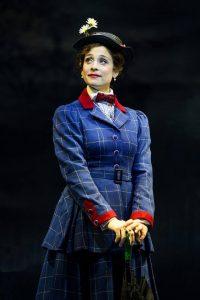
Elena Shaddow as Mary Poppins
Director Mark S. Hoebee has found a perfect actress to play Mary Poppins: Elena Shaddow. She was irresistible–one of the most appealing leading ladies I’ve ever seen in many years of attending Paper Mill shows–when she starred in their production of “Carnival.” In this production–from the moment she comes flying in, in that familiar red outfit–she finds all that is to be found in the role of the world’s most perfect Nanny. (And the utterly convincing flying effects–props to “Flying by Foy”–will delight children and adults alike; I could not see any wires, ever.) I relished her performance from first note to last: just the right mix of warmth and strictness, with the character maintained superbly and consistently throughout. I warmed to her, moreso than the actress I saw play the role on Broadway.
Shaddow is well-supported by a large company–some 30 actors on stage, plus 16 musicians in the pit. The costumes, the settings, the lighting, the special effects–all are impressive. It’s a wonderfully colorful, and often high-spirited production. And the peak moments convey so vividly the joys that are possible in life, the audience responds to those moments with tremendous enthusiasm. The well-cast players, including Mark Evans as Bert, Adam Monley as George Banks, Jill Paice as Winnifred Banks, Abbie Grace Levi and John Michael Pitera (at the performance I saw) as the Banks children, Liz McCartney as Miss Andrew, Jack Sippel as Neleus, Danielle K. Thomas as Mrs. Curry, and Bill Nolte as Admiral Boom, perform with verve.
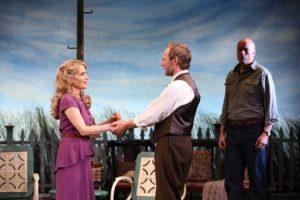
Jean Lichty, PJ Sosko and Larry Bull in a scene from Horton Foote’s “The Traveling Lady” (Photo credit: Carol Rosegg)
The stage musical “Mary Poppins” is also a vivid reminder of just how difficult it is–and just how rare it is–to create a truly great musical. It is based on first-rate source materials–the famed original “Mary Poppins” stories by P. L. Travers and the justly celebrated Disney film–but it not as rewarding or as fully realized as they are.
The film (which was produced by Walt Disney and directed by Robert Stevenson) is sheer perfection from beginning to end–an ever-inspiring source of magic and wonder. I still remember the joy I felt when I first saw it at the Warner Theater in Ridgewood, New Jersey. Like many kids, I was soon singing that film’s memorable songs (written by Richard M. Sherman and Robert B. Sherman): “A Spoonful of Sugar,” “Jolly Holiday,” Feed the Birds,” “Chim Chim Cher-ee,” “Step in Time,” and “Supercalifragilisticexpialidocious.” And those terrific, spirit-lifting numbers (well staged at Paper Mill by director Mark S. Hoebee and choreographer Denis Jones) are the high points of the current stage production.
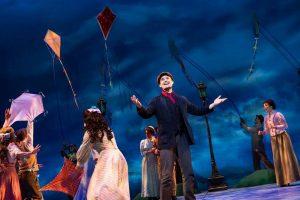
Mary Poppins
You may feel you’ve gotten your money’s worth, just enjoying the way the company puts over “Supercalifragilisticexpialidocious.”
However, the stage musical’s libretto (by Julian Fellowes) is not as satisfying as the film’s screenplay (by Bill Walsh and Don DaGradi). And the new songs by George Stiles and Anthony Drewe don’t come close to the quality of the film’s original songs by the Sherman Brothers (who also wrote the songs for such hit films as “Chitty Chitty Bang Bang,” “The Jungle Book,” “Bedknobs and Broomsticks,” “Charlotte’s Web,” and “The Aristocats,” among others);
the new songs periodically bring the show down.
I absolutely loathe one musical number in the stage version of “Mary Poppins”–the creepy “Playing the Game,” in which the children’s toys come to life; it has menacing feel that the musical does not need. Even the title, “Playing the Game” sounds oddly cynical for this musical.
The 1964 film of “Mary Poppins” is generally acknowledged to be one of the all-time great film musicals–the greatest of the films that Walt Disney himself produced in his long career. Almost everyone loved it. The one significant exception was author P. L. Travers. (And as the creator of the original source material, her feelings were paramount.) She didn’t feel that Disney did justice to her books, and she didn’t get along with Disney, personally. In fact, she felt she’d been slighted by him.
As a result, Travers would not permit Disney to make a film sequel to “Mary Poppins,” or adapt it for the stage. And when she finally agreed to let British producer Cameron Mackintosh do a stage adaptation of “Mary Poppins,” she said that she did not want any Americans–particularly those responsible for the 1964 film of “Mary Poppins”–writing the script or additional songs. (The stage adaptation could use songs from the original movie, but she did not want the writers of those songs to be writing new songs for the stage version.) And that led to the bringing in of British writers Julian Fellowes, George Stiles and Anthony Drewe, whose contributions often seem serviceable at best, rather than inspired.
Oddly and unfairly, the program for the Paper Mill production does not specify which writers created which songs in the score. Each song, in the list of musical numbers, ought to be properly credited.
* * *
“Mamma Mia”–which is playing at the Westchester Broadway dinner theater through June 25th–is a second-rate musical at best. But the star, Michelle Dawson, is giving a first-rate performance–very well acted, very well sung. Her commitment is so total–and her characterization is so real–she makes the material seem better than it is when she is on stage.

Mamma Mia
I’ve long enjoyed her work. Her Broadway credits include “Spider-Man,” “Ragtime,” and “Showboat.” She understudied the leading role in “Mama Mia” on Broadway and played the role on the national tour; she knows the show and the character well. I’ve enjoyed her in leading roles in assorted other musicals at Westchester Broadway, including “Man of La Mancha,” “Oliver,” and “Jekyll and Hyde.” And she commands attention here.
Newcomer Mariah MacFarlane, playing her daughter, does a very fine job, too. I liked her a lot. So two key roles are covered well, and the scenes between mother and daughter ring true. There are some other amiable, agreeable performances in the production.

Larry Bull, Lynn Cohen and George Morfogen in a scene from Horton Foote’s “The Traveling Lady” (Photo credit: Carol Rosegg)
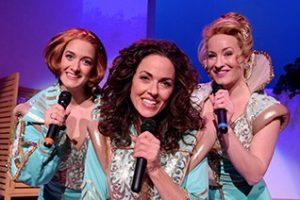
Mamma Mia
But “Mamma Mia” has never been a great musical. Writer Catherine Johnson built a show around pre-existing songs of ABBA (by Benny Andersson and Bjorn Ulvaeus); sometimes the songs serve the story well, sometimes the songs get in the way of the story, slowing it down or grinding it awkwardly to a halt. There is an interesting basic story about a girl trying to find out who her father is, but the basic story gets buried at times by claptrap.
If you loved the songs of ABBA, you might not really mind that this musical proceeds fitfully; you might simply get a kick out of hearing one fondly remembered song after another.
“Mamma Mia” certainly appealed to many people during its long run on Broadway, and it will surely appeal to many people here. This is the 200th production at Westchester Broadway, and producers Bill Stutler and Bob Funking know their audience.
But if you’re looking for a well-crafted musical, in which songs and dances help advance an interesting story, look elsewhere. I saw “Mamma Mia” a couple of times on Broadway–mostly to cheer on friends in the cast–but it never did much for me as a musical. I found it annoying the way the musical numbers sometimes retarded the action, making it difficult to stay caught up in the story.
The Broadway production, I might note, had a highly polished, highly professional sheen to it that is missing here. And that professionalism helped. The direction and choreography here, by Mark Martino, are a cut below the usual Westchester Broadway standards. The production feels uneven. There is one very good dancer in the ensemble–Connor Wince–and it was wonderful seeing him give it his all, and execute every move crisply with flair. His presence helped. But the dance routines were, for the most, disappointing–kitchy and derivative.
* * *
Now that I’ve mentioned a couple of gals I think are deserving of greater recognition, let me tell you about a couple of guys in that same category.
I greatly enjoyed watching Nat Zegree–a recent graduate of Indiana University–light up the stage in “Million Dollar Quartet” at New Jersey’s Paper Mill Playhouse. He stole the show playing Jerry Lee Lewis.

Nat Zegree in Million Dollar Quartet_
Inspired by actual events, “Million Dollar Quartet” deals with four noted performers–Elvis Presley, Johnny Cash, Carl Perkins, and Jerry Lee Lewis. In real life, all four were stars, and Presley, of course, was the most commanding of them all. But Zegree–who makes as much or more out of the role of Jerry Lee Lewis as anyone I’ve ever seen in the role–was by far the strongest entertainer on Paper Mill’s stage. He’s electric–the only one in the cast with real star-power. And he made the other actors seem, at times, like mere pretenders.
“Million Dollar Quartet,” as I’ve noted on a number of past occasions, is a well-written show–one of the best of all of the shows out there that are built around pre-existing songs. This musical play by Colin Escott and Floyd Mutrix was inspired by one night in late 1956 when Elvis Presley, Johnny Cash, Carl Perkins, and Jerry Lee Lewis gathered at Sam Phillips’ “Sun Records” recording studio in Memphis. The score features hits of Presley, Cash, Perkins, and Lewis, including “Blue Suede Shoes,” “Memories are Made of This,” “I Walk the Line,” “That’s All Right,” “Great Balls of Fire.” Good stuff.
The show offers an appealing blend of entertainment, education, and human interest. And production values at Paper Mill–sets, costumes, lighting–were first-rate, comparable to Broadway. Hunter Foster–who played Sam Phillips in the original 2010-2011 Broadway cast and knows this show inside-out–directed this production. And it’s fun.
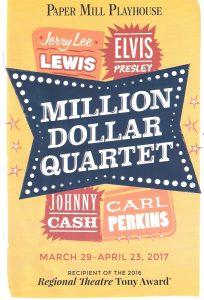 But I wish I could say Paper Mill gave us the “A Team” of available actors for this show. That wasn’t the case. Zegree, as I’ve noted, was sensational. But earlier the season, the Westchester Broadway dinner theater, in Elmsford. New York, presented a long-running production of “Million Dollar Quartet” (also directed by Hunter Foster) that included stronger, more evocative players in the roles of Johnny Cash (Sky Seals) and Elvis Presley (Ari McKay Wilford) than the actors covering those roles at Paper Mill (Scott Moreau, Alex Boniello). It’s a pity that Seals and McKay could not have been hired for this production. James Barry played the embittered Carl Perkins credibly.
But I wish I could say Paper Mill gave us the “A Team” of available actors for this show. That wasn’t the case. Zegree, as I’ve noted, was sensational. But earlier the season, the Westchester Broadway dinner theater, in Elmsford. New York, presented a long-running production of “Million Dollar Quartet” (also directed by Hunter Foster) that included stronger, more evocative players in the roles of Johnny Cash (Sky Seals) and Elvis Presley (Ari McKay Wilford) than the actors covering those roles at Paper Mill (Scott Moreau, Alex Boniello). It’s a pity that Seals and McKay could not have been hired for this production. James Barry played the embittered Carl Perkins credibly.
Paper Mill’s cast included two fine holdovers from the Westchester Broadway cast. I greatly appreciated the warm, solid, and very human portrayal of Sam Phillips by Jason Loughlin. He really has come to own the role. He was good at Westchester, and was even better–deeper–ar Paper Mill. He provided a very satisfying foundation for the show. And Bligh Voth was all right, once again, in a supporting role as Elvis Presley’s girlfriend-of-the-moment; but the part, as written, isn’t of great consequence.
I liked the show. I had a good time. Ideally, though, the four stars on stage, should seem more like stars–should have more presence–and should provide a better balance. Zegree really walked away with the Paper Mill production. It’s been a good long while since I’ve seen a newcomer catch fire like that on stage. I’m glad I witnessed his performance.
* * *
Brian Charles Rooney was the heart of “Berlin to Broadway with Kurt Weill: A Musical Voyage” (directed by Pamela Hunt, and presented as part of the York Theater’s “Musicals in Mufti” series). And that was about as perfect a match of performer and material as one could hope to find. He served as our guide through the music of Kurt Weill, and whether he was speaking or singing, he did so with character and authority, and an appealing raffish charm. He helped conjure up the various shows that Kurt Weill created with Bertolt Brecht (which were celebrated throughout most of Act One), and with Maxwell Anderson, Ira Gerswhin, Langston Hughes, and others (in Act Two).

Brian Charles Rooney
The “Musicals in Mufti” series presents staged concert readings, rather than full productions, of shows worth revisiting. This revue, presenting an overview of Kurt Weill’s music (with format and text devised by Gene Lerner), originally ran off-Broadway in 1972-73. The time might be right to bring it back for a full production. Weill’s songs, from the 1920s, ‘30s, and ‘40s, constitute an extraordinarily rich body of work, and they deserve to be introduced (or reintroduced) to audiences of today. And if this revue were to be given a full production, Rooney should be the first one offered a contract. I loved hearing his voice, whether he was singing (alone or with others) “Mack the Knife,” “The Mandalay Song,” “I’m a Stranger Here Myself,” or “Happy Ending,” or speaking with us about Weill. Rooney’s got an edge that works for this material; he seems very much a denizen of Weill’s theatrical world. I’ve enjoyed Rooney’s work in past productions in New York, both on Broadway (the Roundabout Theater production of Weill’s “Threepenny Opera”) and off-Broadway (“Bedbugs!”). Casting him in this production was an inspired choice.
And I’d say the same about the casting of Rachel de Benedet, who got to sing–and sing brilliantly–many of the night’s best songs, including Weill and Brecht’s “Barbara Song” (English lyrics by Marc Blitzstein), “Surabaya Johnny” (English lyrics by Michael Feinstein), and “Pirate Jenny” (English lyrics by Arnold Weinstein). Rooney and de Benedet, in key roles, anchored the show. They both “get” Weill’s songs thoroughly. They sing with understanding and feeling.

Rachel de Benedet
Tenor Karl Josef Co and baritone Michael Halling were fine–I enjoyed them both–if not quite on the level of Rooney and de Benedet, who really were ideal choices for the material. .
The only singer in the cast I thought was wrong for this show was coloratura soprano Meghan Picerno. She’s sung with the New York City Opera, and I’m sure she’d be perfect for certain types of roles, and certain types of songs. She hit every note cleanly and precisely, but with a formality that I found off-putting. She projected an air of “the academy.” You could hear, in each phrase she sang, years of classical training. Her pristine voice seemed, at times, too carefully trained and controlled to really suit the songs in this revue. If you’re going to sing a line like “show me the way to the next whiskey bar,” you’ve got to sound like you’re quite at home in whiskey bars. To me, Picerno sounded like someone who’d never been in a bar in her life. (I could imagine her having spent years in a convent or a conservatory, sheltered from the world.) I might add, I have never met her; I have no idea what she is like in real life; I’m only writing about her persona on stage. I found her unconvincing on some of the songs. Her voice was clearly well-trained. But you need to seem like you’ve lived a bit, and have been through the mill a time a two, and have some bruises, if you’re going to do justice to some of Weill’s great songs. I’m not knocking her as a singer per se, but as a singer for some of the songs in this show, which call for rougher edges than she’s got.
But I’d love to see “Berlin to Broadway with Kurt Weill” get a full commercial production. No show I saw this past year had so many richly rewarding songs.
And now, let me mention a few other productions and performers I caught, one place or another, this past season, that impressed me.
* * *
I’m very glad I got to see “A Chorus Line”–one of the all-time great musicals, which I’ve seen many times since it originally premiered in New York–at the Professional Performing Arts School. That’s one of New York’s top high schools for youths interested in the performing arts, and it’s a good place to spot up-and-coming artists-to-watch.
 I was happy to be able to cheer on some talented friends in the production, such as actors Connor Barth and Jonah Barricklo, and music-director Brett Kristofferson (who’s music-directed for me in the past, and supported this production strongly). Barth played, with compasssion, “Zach,” the demanding, godlike director who is auditioning dancers–who share their life stories with him (and us)–for a new musical. And it was great fun seeing Barricklo, who in real life is a superb dancer, playing well a bad dancer who gets cut early in the story. (It takes a very good dancer to be able to intentionally dance badly and make it interesting.)
I was happy to be able to cheer on some talented friends in the production, such as actors Connor Barth and Jonah Barricklo, and music-director Brett Kristofferson (who’s music-directed for me in the past, and supported this production strongly). Barth played, with compasssion, “Zach,” the demanding, godlike director who is auditioning dancers–who share their life stories with him (and us)–for a new musical. And it was great fun seeing Barricklo, who in real life is a superb dancer, playing well a bad dancer who gets cut early in the story. (It takes a very good dancer to be able to intentionally dance badly and make it interesting.)
The school boasts some wonderfully gifted, committed young performers. And in productions at that school this year I saw some young performers I’d never seen before whom I expect to see on Broadway in years to come. Incidentally, P.P.A.S. is one of very few high schools that could do justice to “A Chorus Line.” And I must stress, they performed the bracing original script, not the dumbed-down adaptation for younger people that is available. (If schools attempt “A Chorus Line,” they usually do the G-rated school version, singing innocuous words like “This and That” instead of “Tits and Ass”–changes which certainly weaken the material.)
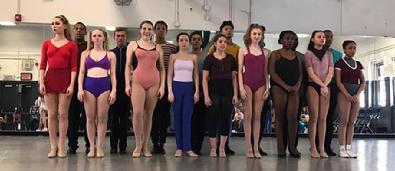
A Chorus Line
The youths at P.P.A.S.performed the iconic original choreography on four key numbers: the opening, “One,” “Music and the Mirror,” and the brilliantly executed Finale. And if sometimes the challenges were beyond their present capabilities–“Music and the Mirror” is a very tough number for any dancer, especially a young dancer–youths learn by being challenged.
On other numbers, we saw new musical staging, devised by director/choreographer Kyle Pleasant to showcase the strengths of the available performers. And pow!–some of the freshly staged numbers landed terrifically. Drew Minard–an amazing dancer/singer–put across “I Can Do That” as effectively as I’ve ever seen it done, anywhere–the singing, the dancing, the elan; all first-rate. He was absolutely terrific–a tough act to follow. (He was also a standout in “How to Succeed in Business,” which I caught earlier in the season at the school–great presence on stage. That production, incidentally, starred Talon Ackerman, who first impressed me when he was in “Leap of Faith” on Broadway. He still sings beautifully, and I was happy to see his erstwhile “Leap of Faith” co-star, Raul Esparza, in the audience to support him.)
Other peak moments in “A Chorus Line”? Analia Heredia took ownership of “What I Dd for Love,” making me believe every word of that overly familiar ballad, as if it were her own heart speaking. She was fresh, she was earnest, she was spontaneous. It couldn’t have been better.
 Ava Arkin was “Sheila”–strong, seductive, bossy–exactly. Tyqaun White, whose work I’ve enjoyed before, made his character, “Richie,” a standout. A lot of great moments in the show, building up to the finale which deserved the standing ovation it got.
Ava Arkin was “Sheila”–strong, seductive, bossy–exactly. Tyqaun White, whose work I’ve enjoyed before, made his character, “Richie,” a standout. A lot of great moments in the show, building up to the finale which deserved the standing ovation it got.
The show has extra resonance for me because I was friends with some members of the original cast, particularly the late Thommie Walsh. (To me, it felt almost like Thommie was in the room, when the young actor playing “Bobby,” Anthony Garcia, uttered lines that I know well were from Thommie’s life, lines Thommie contributed verbatim to the script. I wonder if the young actors on stage–or the audience members cheering them on–all understood that the lines spoken on stage were all contributed by the performers who did Michael Bennett’s original workshop production and Broadway production.) Gillian Lieberman played Cassie, based in part on Donna McKechnie, who so famously originated that tough role (and still does well the original dancing, and teaches it in her master classes.) . And I could not help thinking of Thommie and Donna, and others in the original cast, and what became of them.
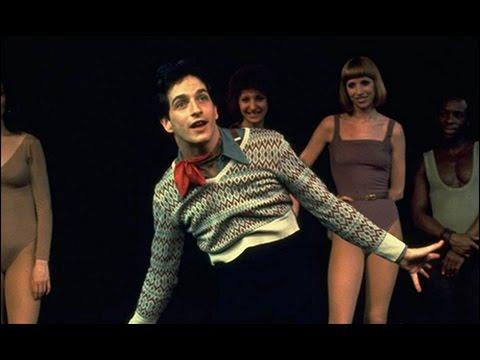
Thommie Walsh
Incidentally, the same day that I was seeing “A Chorus Line” in New York City, the first “Thommie Walsh Scholarship”–to help aspiring performers–was being awarded at a gala at the Merry-Go-Round Playhouse in his old hometown of Auburn, New York, with his sister, Barbara Walsh, there to represent him. Thommie–who achieved great success as a director/choreographer (often collaborating with Tommy Tune)–was a kind, down-to-earth guy, taken from us too soon. He gave up performing after “A Chorus Line,” to focus on working as a choreographer and director. Among his many Broadway credits: “The Best Little Whorehouse in Texas,” “A Day in Hollywood/A Night in the Ukraine,” “Nine,” My One and Only,” and “My Favorite Year.”
I learned more about show business, just walking down the street with Thommie, than I could learn from any book. And he was all about the work–not about the personal glory. A Tony Award-winner, he helped out on a number of projects, quietly, without worrying about public recognition, besides the projects for which he was well-known. He could doctor any production and make it better. When I presented the New York premiere of “Danny and Sylvia,” as part of my theater festival, he really shaped the production moreso than the credited director. (I wanted to give him credit, but he generously did not want to take credit away from the original director. But it was Thommie who made that show really shine.) He contributed–as an unbilled “show doctor”–to such Broadway musicals as “The Grand Tour,” “Black and Blue,” and “The Tap Dance Kid,” and choreographed some of the numbers in “Grand Hotel.”
* * *
I drove out to Bellport, Long Island, to catch the Gateway Playhouse’s well-cast production of Jonathan Larson’s Pulitzer Prize-winning musical “Rent.” And I headed home afterwards, happily, with songs like “Without You,” “Will I,” “What You Own,” “Seasons of Love,” and “La Vie Boheme” playing in my head once again.
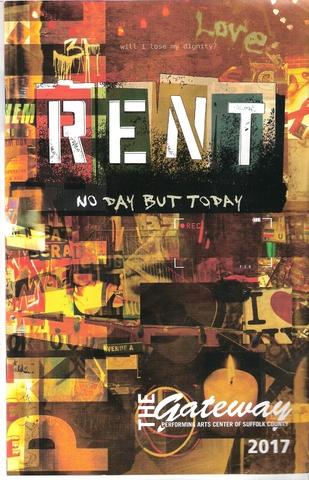 I have seen productions of “Rent,” both good and bad, many, many times since Larson wrote this groundbreaking show 21 years ago–Off-Broadway at the New York Theater Workshop; then repeatedly on Broadway; and then off-Broadway again, after the long original Broadway run ended. I caught the national tour when it came to Newark, New Jersey. I’ve seen regional productions in the states of New York (Westchester Broadway Theater) and Connecticut (Triarts Sharon Playhouse). I’ve seen productions at the community-theater level (Wayne, NJ, YMHA); high-school level (Trumbull, Connecticut); and college level (Hofstra University).
I have seen productions of “Rent,” both good and bad, many, many times since Larson wrote this groundbreaking show 21 years ago–Off-Broadway at the New York Theater Workshop; then repeatedly on Broadway; and then off-Broadway again, after the long original Broadway run ended. I caught the national tour when it came to Newark, New Jersey. I’ve seen regional productions in the states of New York (Westchester Broadway Theater) and Connecticut (Triarts Sharon Playhouse). I’ve seen productions at the community-theater level (Wayne, NJ, YMHA); high-school level (Trumbull, Connecticut); and college level (Hofstra University).
And I continue to find more in “Rent.” I’m still surprised by how strongly it affects me. The ending hit me very powerfully, out at Gateway. Sitting near me, by chance, was a 14-year-old girl–a vocal student of one of the stars of the production, Jeremy Greenbaum–who’d never before seen “Rent.” She loved it. And when it was over, she said to me enthusiastically, “Doesn’t it make you just want to get out and do things?” It gave her inspiration, she noted–just as it always has given inspiration to me. Jonathan Larson, who wrote the book, music, and lyrics, created a profound work, which I greatly admire. And this production worked.
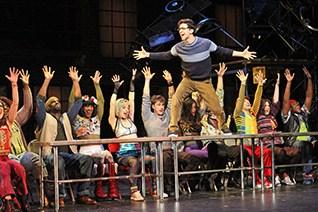 Larson’s musical, about young artists, struggling to live fully–despite challenges of poverty, illness, the threat of impending death–was drawn from his own experiences, and those of his friends. (In the life-support scene, the names of three characters are the names of actual people Larson knew, who’d died of AIDS.) At the end of the show, we see footage of a film that the show’s narrator, “Mark” (a kind of stand-in for Larson, beautifully played by Jeremy Greenbaum) has made, memorializing his friends and their struggles. And in creating “Rent,” Larson masterfully memorialized his friends, too. He died just before “Rent” opened. But the work, if performed well, has great power. And at Gateway, to an extent that took me by surprise, I felt the work also has great poignance.
Larson’s musical, about young artists, struggling to live fully–despite challenges of poverty, illness, the threat of impending death–was drawn from his own experiences, and those of his friends. (In the life-support scene, the names of three characters are the names of actual people Larson knew, who’d died of AIDS.) At the end of the show, we see footage of a film that the show’s narrator, “Mark” (a kind of stand-in for Larson, beautifully played by Jeremy Greenbaum) has made, memorializing his friends and their struggles. And in creating “Rent,” Larson masterfully memorialized his friends, too. He died just before “Rent” opened. But the work, if performed well, has great power. And at Gateway, to an extent that took me by surprise, I felt the work also has great poignance.
The leads were all very well cast, and the actors were individuals, offering their own take on the material. The strong score was well sung. There were minor flaws in this production, which I’ll get to in a moment. But for the most part, director Matt Karris and the actors he chose, got well into the spirit of the work. They performed with feeling, and it was impossible not to be carried along.
This production, in many ways–from the set design by Brittany Loesch to the musical arrangements by Steve Skinner and Tim Weil–had the feel of the original New York production. The leads–including Greenbaum as “Mark Cohen,” Anthony Festa as “Roger Davis,” Michelle Veintimilla as “Mimi Marquez,” Jared Dixon as “Tom Collins,” Andres Quintero as “Angel Schunard,” and Moeish McGill as “Joanne Jefferson”–understood the characters and offered realistic portrayals.
I felt that the show was in good hands from the first few numbers. I liked that the performers were interesting in their own right. And–in contrast to what I’ve witnessed in some less-satisfying regional productions–they were not trying to copy the phrasing and inflections of the original New York cast members (as preserved on the original cast album and in the film adaptation of “Rent,” which retained most of the original cast). That made this production feel more “real” than some I’ve seen where actors were clearly doing imitations of the performances of the show’s original stars. They had a good feel for the material–which has not always been the case with regional productions I’ve seen. And the actors articulated clearly. This is one production of “Rent”–unlike some others I’ve seen–in which you could understand every word. And that’s important, because there’s a lot going on in this show. If actors garble words–a common problem in the theater these days–it is easy to get lost. And Larson’s words deserve to be heard.

Jeremy Greenbaum
For the most part, I liked this production, and I left the production feeling uplifted. Were there some flaws? Sure. None were deal-breakers for me; but I need to mention them. The musical staging of one important number,”Contact,” was simply wrong. The number should be performed with great Dionysian energy; the staging should suggest couples coupling–people seeking contact with one another, affirming life in the face of death. Larson’s own stage directions specified couples moving under sheets. But the strong eroticism of the original New York staging was greatly toned down in this Long Island production. And instead of couples making contact–as suggested by the very title of the number–we saw individuals dancing in place; that felt like a cop-out to me; Larson’s intent was compromised. I’m guessing that someone (director Mark Karris, choreographer Gerry McIntyre, Executive Artistic Director Paul Allan?) may have decided to pull back a bit on the sexuality, to soften the scene and make it a bit “safer” for older, more conservative ticket-buyers at a regional theater. But if you’re going to present “Rent,” present “Rent”–commit fully to the material. The scene pays off better if it is more “in your face,” and has a kind of frenzied energy that was missing here. Playwright Larson and original director Michael Greif drove the scene home strongly, so that in the original production tension mounted and mounted in the theater–until we learned that “Angel,” a character we’d come to love, had died. And in this production, some of the impact of the original staging was lost.
There were other occasional moments in the show when I wish more passion was projected. (Passion really is at the heart of this show.) And occasionally, one of the starving artists appeared too well-dressed. I sometimes wished the costume designer had picked clothing from second-hand stores, or found clothing that looked more consistently like clothing starving artists on the Lower East Side might wear. But these are relatively minor flaws in a generally very rewarding production of a unique, and still provocative show.
* * *
I am so happy I got to see my longtime friend Victoria Leacock Hoffman–a very special person; kind, smart, instinctive, and “giving” by nature–honored by the Keen Company in New York City. Artistic Director Jonathan Silverstein presented her with his theatrical company’s first annual “Vision Award.” The gala celebration, held in a Fifth Avenue penthouse space, was quite a night. There was a lot of love in that room,. expressed via songs and words by Amy Spanger, Molly Ringwald, Monica Lewinsky, Jonathan Silverstein, Kathleen Chalfant, and others. 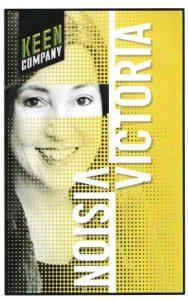
Victoria Leacock Hoffman has made her mark as a filmmaker, AIDS educator, and producer. And she’s been a great “keeper of the flame” for Jonathan Larson. (If you buy the published script for “Rent,” for example, you’ll note she’s written the introduction.) She was his intimate friend–no one was closer to him–and his original producer. In his lifetime, she got his shows up, on a shoestring; she believed in him when few others seemed to, and she aided him greatly.

Victoria Leacock Hoffman
Although “Rent” has bought in hundreds of millions of dollars in revenues, Jonathan Larson never saw any of that money; he died unexpectedly of an aneurism, at age 35, just before his masterwork opened. In his lifetime, he was pretty much a starving artist, working as a waiter at the Moondance Diner to play his bills, while he also worked on his shows and songs. She helped get his exposure for his work, in venues like the Village Gate. (“Rent” was inspired, in part, by the deaths, due to AIDS, of several of Larson’s friends. Victoria Leacock Hoffman reflected that, with several of their friends seriously ill or dying of AIDS, it never occurred to anyone that Jonathan might die soon; he wasn’t on the list of people anyone was worrying about, in terms of health.)
Since Larson’s passing, she’s done everything she could to promote his legacy. She got his semi-autobiographical show “tic, tic… BOOM” to the stage for a successful, posthumous Off-Broadway run (with his songs and a revised book by David Auburn). And the show went on to enjoy international success. Actor Raul Esparza, whom she picked to represent Jonathan Larson in the original Off-Broadway production of “tic, tic… BOOM,” penned these words in tribute to her: “Victoria, You shaped the trajectory my career would take in New York by believing that I could bring Jon back to life, if only for 90 minutes every night. You believed in my talent so deeply that I walked away from a starry Broadway debut to put together the messy pieces of our rough-ass show in a flophouse on Jane Street. ‘Go down among the prostitutes, roller-skating drag queens, and late-night club emcees in the Meatpacking District and make some damn art.’ It seemed the only sensible thing to do: go where the love is. And how I loved you back.”
Jonathan Larson’s close friend, Matt O’Grady, spoke at the gala, suggesting that when you’re with Victoria, you know interesting things are going to happen. (And I know from experience that is definitely true.) Jonathan’s father, Al Larson, sent a moving letter, which was read aloud. In the letter, he noted she was Jonathan’s “defacto producer, unofficial agent, and number-one booster….. She helped Jon ‘make something out of nothing,’ frequently willing events to happen with little more than optimism, spirit and unwavering belief in his work…. I’m proud to say, ‘We love you, Vic.’” And he added that the Larsons honored her “not just today, but everyday.” Lin-Manuel Miranda saluted her via a statement that said, in part, “You are the most devoted and passionate of friends and advocates, and the world is better because of your passion and tenacity.” Timothy Britten (“Toby”) Parker from the original cast of “Rent”–one of my favorite people in this business–noted in tribute: “It seems to me she’s lived three or four lives in this life, while many of us are living just one! I think that’s because she has reached out and reached in to other people and brought out such good. She has celebrated them and grieved them, and through it all has maintained her preternatural optimism.” For him, the night was an occasion for celebration–and also for reflection on the impactful losses of Jonathan Larson, and of friends of Jonathan’s and Victoria’s and his.
Victoria’s good friend Monica Lewinsky remarked that it was her good fortune to meet Victoria at a time–trying to rebuild her life in NYC, after her experiences in Washington, DC– when she was really having trouble trusting people; she found that Victoria Leacock Hoffman was someone she could trust, as were the friends she made through her.
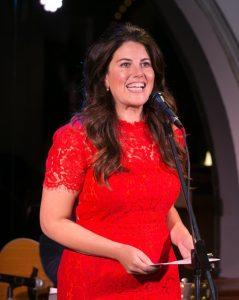
Monica Lewinsky
Broadway and Hollywood’s Amy Spanger and Molly Ringwald sang with zest

Molly Ringwald
The Drama Desk Award-nominated cast of the Keen Company’s recent revival of “tick, tick… BOOM” performed, too. Youths who were not even born when Jonathan Larson wrote “Seasons of Love” (from “Rent”) sang it with heart: Petra Brusiloff, Marina Davey, Natalya Gammon, Malcolm Grant, Rose Hornyak, Emerson Thomas-Gregory, Mohammad Murtaza.
Sitting next to Toby Parker at the gala–it was so good to see him!–I was remembering watching him and his castmates from “Rent” sing that song at the recording session for the original cast album. And I was remembering, too, later attending the recording session for “tick, tick… BOOM,” And there was Jerry Dixon (from the original cast of “tick, tick…. BOOM”), and playwright David Auburn, and so many other talented people. It was an important night, bringing together all sorts of people whose lives have been touched, in one way or another, by Victoria. And it was great to hear her own many good works acknowledged. I value our friendship, and I will always remember this ni
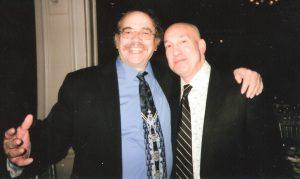
Chip Deffaa with Toby Parker
ght–perhaps the best tribute kind of night I’ve attended. The whole night, incidentally, also served as a benefit for the Keen Company.
When I got home, I found a message from a great friend I’d made on one of my theatrical trips to Korea–and I owe Victoria Leacock Hoffman thanks for that, too. I would never have gone to Korea at all, were it not for her. She was with me one night, watching my show “George M. Cohan Tonight!,” just after it opened Off-Broadway at the Irish Rep. A fellow introduced himself to me, telling me that his name was Hansaem Song, he was from Seoul, and he wanted to produced my show in Korea. I was going to dismiss him–it just seemed so far-fetched–but Victoria told me to take him seriously, saying, “They love Jonathan’s work in Korea and they will love yours, too. I’ve gone twice, with production’s of Jonathan’s ‘tick, tick…. BOOM.’ You must go!” I listened to Victoria; the Korean productions of my shows went over wonderfully. And–as if a reminder of Victoria’s magic–the very first thing I saw when I arrived in a Korea–as I wrote Victoria at the time–was a poster for “tick, tick…. BOOM.” She has a way of helping people fulfill their destinies. I’m glad I know her.
* * *
I’m almost out of time here. But I can’t leave out one show that certainly had an impact on me–the Nutmeg Ballet Company’s “Impact” show. There isn’t space to describe the entire program, which ranged from excerpts from familiar classical ballet works, such as “Giselle” and “Coppelia,” to new choreography, created expressly for the Nutmeg Dancers. My apologies to the many fine dancers I will not be able to mention today. I can’t comment on each piece or on each dancer, even if I notice, appreciatively, while watching performances, lots of fine moments, or areas of individual improvement (how good Benton Stivali, for example, has become at turns).
I was most intrigued by the new works presented in the “Impact” show–such as the olive green-clad dancers executing sweet/sad moves in Kate St. Armand’s “Passage”; and the fascinating mix of old and new, in Brian Reeder’s “Occupied.” He paired lively Swing Era recordings by European artists, with movements suggesting people living under occupation–hearing no evil, seeing no evil, while others were being carried off. (And while that was happening, singers were cheerily crooning, “Some of these days, you’re gonna miss me,. honey….”) A brilliant piece, with perfectly chosen vintage recordings from countries that were occupied during the Second World War, coupled with moves suggesting life under oppression. And it also felt, to me like a commentary, in a way, on America in the age of Trump. An evocative piece.
For me, the high point of the show was “Onetothree,” choreographed by Kinsun Chan–an abstract work involving a total of six dancers, using three pieces of music, with choreography consisting of solos, duets, and a trio. It was a perfect meshing of performers and material–and I enjoyed it as much as anything I saw anywhere all year. (I was lucky enough to get to see it again, at Nutmeg’s final presentation of the season, in May, and responded just as strongly.)
The piece showcased particularly well Andris Kundzins and Alma Evertz. I was not surprised by how magnificently they danced. They’ve long impressed me. No dancers at Nutmeg have greater technical skills. They’re eloquent dancers of great promise. And I almost expect any pairing of them to be very satisfying. It was a wonderful surprise, though, to see Julius Taiber, who is younger than them and less experienced, join them on stage in this work and fully hold his own as a peer. (Talented young dancers are sometimes capable of progressing by great leaps and bounds. They might not feel like they’re dancing any better, from one day to the next–but to an outside observer, who only sees them two or three times a year, their growth as artists can be tremendous and startling.) It’s given me great joy, seeing him come into his own. His growth as a dancer, over the last few years, is noteworthy. I’m grateful I get to witness it. I’m sure a lot of hard work and dedication goes into that progress. But he makes it look effortless, and fun. Which is as it should be. His dancing hangs together well; it coheres; it of a piece. And it has great vitality. And he–no less than the senior dancers, Kundzins and Evertz–made that work soar. Oh, I expected Kundzins and Evertz to dance on that level; it was neat seeing Taiber\up there, too.
For me, that performance really was inspiring. And I choose my words carefully. I’m not just saying :”inspiring” in some loose, general abstract way. Driving home after the “Impasct” show, the dancing on “Onetothree” was sort of echoing in my brain, and it inspired a song that I began to write on that drive home. When I got home, I began setting the lyrics on paper. The song will eventually be part of a show I’m developing, and will be recorded; I’ll know it would not have existed had I not chanced to see Taiber, Kindzins, Evertz dancing that piece that day. That’s inspiration!
It will probably be six months or more before I see any of these Nutmeg dancers again. I can’t wait!
* * *
I’ve been spending a good bit of time, of late, in the recording studio. It makes me very happy that we’ve now completed, and have just released, the original cast album for my show “Mad About the Boy,” with the terrific company from our production at the 13th Street Theater: John Brady, Cody Jordan. Joris de Graaf, Luca Fric, Benjamin Grier, Amanda Andrews, Katherine Paulsen, Toby Medlyn, Maite Uzal, Michael Knowles, Shinice Hemmings, Michael J. C. Anderson, Al Roths, Richard Danley. I was very proud of that whole cast and am delighted to have their good work documented. And it’s available now from Amazon.com, CDBaby.com, etc.
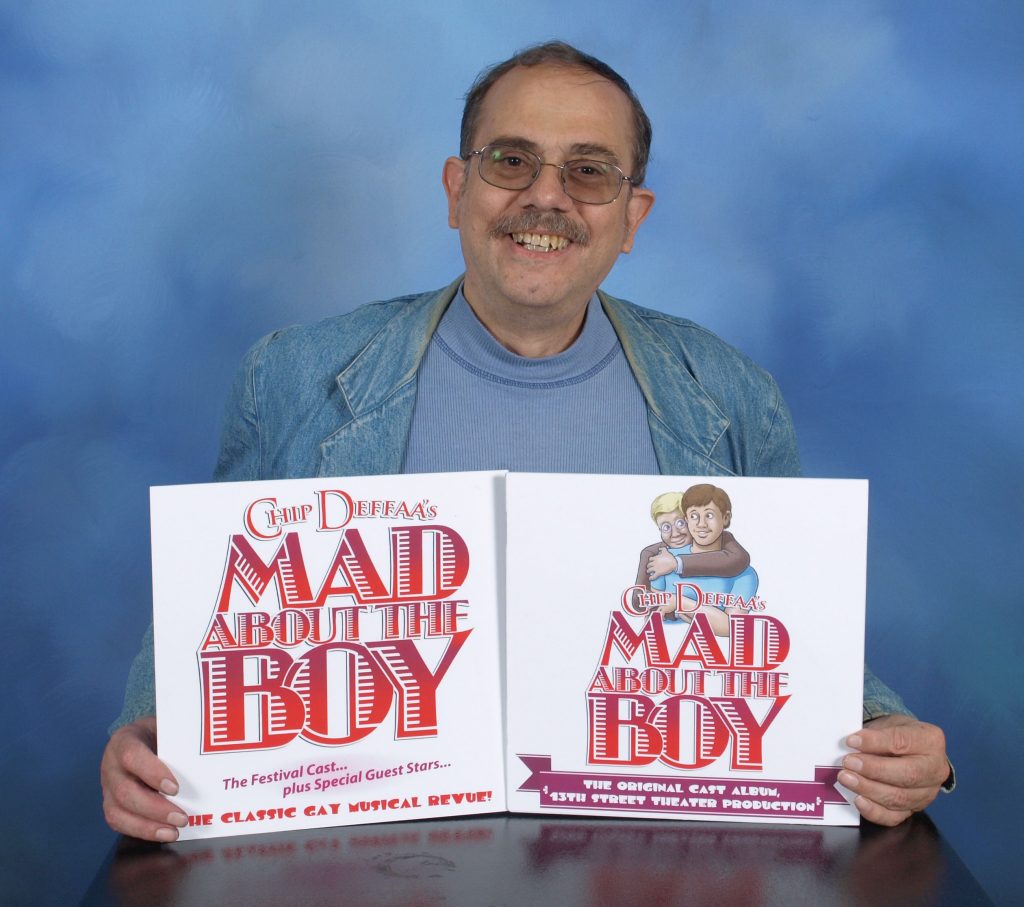
Chip Deffaa with “Mad About the Boy” cast albums
And within a couple weeks, there will actually be a second “Mad About the Boy” cast album—this one featuring performers from a festival production, joined by some very special guest stars.
— CHIP DEFFAA, June 24, 2017

Great & interesting & very informative!